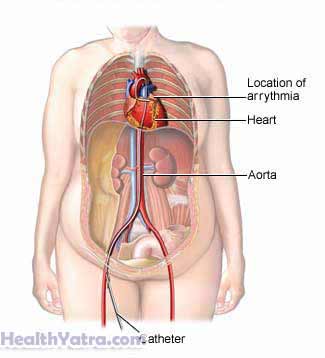تعريف
Cryoablation uses extremely cold temperature to destroy cells. Cardiac catheter cryoablation is used to destroy selected heart cells.
أسباب هذا الإجراء
The procedure is done to disable heart cells that are creating an irregular heartbeat (arrhythmias). After the procedure, normal heart rhythm should be restored.
المضاعفات المحتملة
Complications are rare, but no procedure is completely free of risk. If you are planning to have cardiac catheter cryoablation, your سيقوم الطبيب بمراجعة القائمة من المضاعفات المحتملة، والتي قد تشمل:
- نزيف
- العدوى
- Pain at the catheter insertion site
- Blot clot formation
- Injuries to blood vessels or the heart
- عدم انتظام ضربات القلب
- نوبة قلبية
- Heart perforation
تشمل العوامل التي قد تزيد من خطر حدوث مضاعفات ما يلي:
- التدخين
Your level of risk may be related to the specific arrhythmia that you have and any underlying حالات طبيه.
ما يمكن توقعه
قبل الإجراء
طبيبك سوف المرجح أن تفعل ما يلي:
- Perform electrophysiology studies to pinpoint the location of the abnormal rhythms
- Instruct you to stop taking medicines previously used to control your arrhythmia
المؤدية إلى الإجراء الخاص بك:
- Do not to eat or drink anything for up to eight hours before the procedure.
- You will be admitted to the hospital.
- اتبع تعليمات طبيبك.
التخدير
A local anesthetic will be given by needle. It will numb the area where the catheter (tube) will be inserted. You will also receive a mild sedative through an IV in your arm. This will help you to relax during the procedure.
الوصف الداخلي
The special ablation catheter will be inserted into a blood vessel in the groin, upper thigh area, arm, or wrist. The area will be cleaned. It will also be numbed with anesthesia.

The catheter will be passed up the blood vessel to your heart. Your doctor will be able to see the catheter with a special x-ray machine. It will be seen on a nearby screen.
Your doctor will locate the origin of your arrhythmia. This will be done by setting off the arrhythmia with a special catheter tip. Once the location is found, the area will be cooled with the tip of the catheter. If it is the right area, the cold will temporarily stop the arrhythmia. If it is not the right area, the tip is removed and the tissue will not have any damage.
When the right area is found, the tip of the ablation catheter will be cooled down to -70°C. This extreme cold will freeze and scar the heart tissue. The damage will eliminate the arrhythmia. Your doctor will then try to reproduce the arrhythmia. The tip will be applied again until the arrhythmia can no longer be reproduced.
مباشرة بعد الإجراء
You will be moved to a recovery room. The staff will observe you for a few hours for symptoms, rhythm problems, and bleeding from the catheter sites. You may feel groggy from the sedative.
You will likely need to lie still and flat on your back for a period of time. A pressure dressing may be placed over the area where the catheter was inserted to help prevent bleeding. It is important to follow the nurses’ directions.
كم من الوقت سيستغرق ؟
3-6 hours (may be longer)
كم هو مؤلم ؟
You may feel some minor discomfort as the catheter is inserted. You may feel light-headed, experience a rapid heartbeat, or experience chest pain during the freezing process.
متوسط الإقامة في المستشفى
Most patients stay overnight for further observation. Your doctor may choose to keep you longer if complications arise.
رعاية ما بعد العملية
في المستشفى
- The catheter insertion site may be bruised and sore.
- If the groin area was used as the insertion site, you will be instructed to lie in bed with your legs out straight.
- If the wrist or arm was used as the insertion site, you will not need to stay in bed.
- The insertion site will be monitored for signs of bleeding, swelling, or inflammation.
- Your vital signs will be monitored.
في البيت
عندما تعود إلى المنزل بعد الإجراء ، قم بما يلي للمساعدة في ضمان التعافي السلس:
- Take aspirin as prescribed. It is often recommended for 2-4 weeks. This will help to reduce the risk of clot formation at the ablation sites.
- Return to any usual light activities, such as walking or taking the stairs. Refrain from heavy lifting or any strenuous activity for 24 hours. In most cases, you will be able to return to your normal activity level within a few days.
- Schedule a follow up visit with your doctor. The catheterization sites will need to be checked.
This procedure has an extremely high success rate and a low recurrence and complication rate. But, if you:
- Have atrial fibrillation or ventricular tachycardia, you may need to continue antiarrhythmic therapy
- Are undergoing cryoablation of the AV node, you may require a pacemaker
استدعاء الطبيب
بعد مغادرة المستشفى، اتصل بطبيبك في حالة حدوث أي مما يلي:
- علامات الإصابة, بما في ذلك حمى وقشعريرة
- احمرار أو تورم أو ألم متزايد أو نزيف مفرط أو إفرازات عند إدخال القسطرة
- Your leg feels cold, turns white or blue, or becomes numb or tingly
- سعال ، ضيق تنفس ، ألم في الصدر ، غثيان أو قيء شديد
- Discomfort in the jaw, chest, neck, arms, or upper back
- Dizziness or weakness
في حالة الطوارئ ، اتصل على المساعدة الطبية على الفور.
